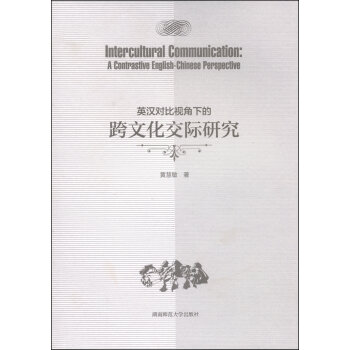英汉对比视角下的跨文化交际研究
作 者:黄慧敏
出 版 社:湖南师范大学出版社
出版时间:2014年02月
定 价:38.00
I S B N :9787564814991
所属分类: 人文社科 > 文化 > 文化理论与研究
标 签:
The book is intended for graduate students and other learners who show a great interest in language, culture and intercultural communication. It covers ten chapters alto-gether and involves: 1) an elaboration of how three new motivations and China's rise on the world stage speed intercultural communication today; 2) an interpretation of how cul-ture and communicat'ion are related to each other, and what are their respective characteristics and modals, and what are intercultural communication and their forms; 3) a compari-son between Chinese and American cultures from three per-spectives of different cultural patterns, value dimensions and the deep structure of culture; 4) a description of language characteristics, function, and its relationship with culture,and an explanation of translation as a culture and language transference and as an equivalence-seeking in different cultures or languages; 5) a discussion of thetoric functions as thinking modes to reflect cultures and as an effective means to convey the intention or thought of speakers in intercultural communication; 6) a case analysis of intercultural communication in education and medical treatment between Xiang and Ya for more than a hundred years; 7) a presentation of some examples selected from graduates to discuss and comment on the Chinese Movie Guasha in the perspective of intercultural communication as an ending of the book.
Introduction
Chapter 1 Great Changes in Intercultural Communication
1.1 The Importance of Intercultural Communication
1.2 Five Stages in the Progress of Human Communication
1.3 Three New Motivations of Intercultural Communication
1.3.I New Technology and Information Systems
1.3.2 New Explosion of the World's Population
1.3.3 New Economic Arena
1.4 China's Rise on the World Stage
Chapter 2 Settings of Contacts and Human Relationship
2.1 Important Settings of International Contacts
2.1.1 Education Environment
2.1.2 Business Environment
2.1.3 Media Environment
2.2 Personal and Public Relationship
2.2.I Friendship and Colleagues' Relationship
2.2.2 Immigration and Mixed Marriage
Chapter 3 Communication and Culture
3.1 Communication
3.1.1 Definitions of Communication
3.1.2 The Complexity of Communication
3.1.3 Components of Communication
3.1.4 Characteristics of Communication
3.1.5 Modals of Communication
3.2 Culture
3.2.1 Definitions of Culture
3.2.2 Characteristics of Culture
3.2.3 Functions of Culture
3.3 Relationship Between Communication and Culture
Chapter 4 Intercultural Commumcation
4.1 Definitions of Intercultural Communication
4.2 Elements of Intercultural Communication
4.3 Forms of Intercultural Communication
4.4 Domains of Intercultural Communication
4.5 A Main Disparity of Thinking Modes Between Eastern and Western in Intercultural Communication
Chapter 5 Cultural Pattems and Value Dimensions
5.1 Culture and Perception
5.1.1 Culture's Influence on Perception
5.1.2 Beliefs and Values
5.1.3 One of Primary Differences Between Chinese and American Values:Face & Freedom
5.2 Dominant Cultural Patterns in Intercultural Communication
5.2.I Dominant American Cultural Patterns
5.2.2 Dominant Chinese Cultural Patterns
5.3 Diverse Value Dimensions
5.3.1 Hofstede's Value Dimensions
5.3.2 The Kluckhohns and Strodtbeck's Value Orientations
5.4 Hall's High-context and Low-context Communication
Chapter 6 The Deep Structure of Culture
6.1 World View
6.1.I Religion- One's Spiritual View as a World View
6.1.2 Five Big Religions in the World and a Comparison Among them
6.2 History
6.2.I American History's Influence on the American Character
6.2.2 Chinese History's Influence on the Chinese Character
……
Chapter 7 Verbal Communication
Chapter 8 Nonverbal Communication
Chapter 9 Attitudes Essential to Intercultural Communication: A Sample Analysis
Chapter 10 nthe Movie Guasha-A Cultural Clash Between Chinese and American Values: Discussion and Comments
Bibliography
2.2 Personal and Public Relationship
The result of the globalization of education, business and media environ-ments is naturally leading to the fast increase in personal and public relation-ship of intercultural communication. Take China as an example, some great changes in Mainland have taken place since the reform and opening of China in the past 30 years. Data from CCTV shows that in 1976 there were only 67 of-ficials of foreign affairs in total in American Embassy to China, but in 2008 there are already 1167 officials in total there. In 2013, even in a university of the US, emails to a Mandarin teacher from the US government can be re-ceived, asking her to inform the class that some American students who can speak Chinese fluently would be needed for some positions of the visa officials to China, if they succeed in applying for those positions. Apparently, inter-cultural communication appears a crucial part of orchestrating a solution on many aspects. Meanwhile, friends, colleagues, partners and mixed marriages between one culture and another, produce many problems for us to deal with in these encountering. These intercultural contacts are often synchronous and harmonious, but sometimes are fraught with friction, conflict and misunder-standings as well. Therefore, making a contrast between the American and Chinese in communication to promote the quality and quantity in intercultural communication seems essential to us all.
2.2.1 Friendship and Colleagues Relationship
In talking about friendship and colleagues' relationship, Chinese people are publicly recognized as very hospitable. In general, they tend to take great care of their friends or guests and try to help them with everything esp. when their friends and guests visit them. Their hospitality is usually more than a Westerner can understand sometimes. At the same time, they expect others return to some degree too. and receive the same kindness from others when they become guests of theirs. While American people, esp. Northern Ameri-can are trained to feel highly time-stressed and to do things for themselves.
They would feel uncomfortable when surrounded by people who try to be kind-hearted all the time. They would rather be alone and arrange their time in their own way.so as to take in as many new things as possible in another cul-ture. What they expect is help in need. Therefore, both cultures with their different traditions of hospitality would lead to the expectation of self-reliance versus expectations of companionship and warmth all the time, and Chinese overdone hospitality versus American underdone hospitality. Both will suffer if they can't know where the difference lies. Here is an example worth ourconsideration in learning intercultural communication.
……
